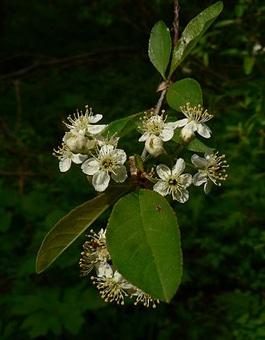

Both food and shelter for wildlife
Often more of a shrub than a tree, bitter cherry creates beautiful red fruits that look delicious but taste awful. Parts of the bitter cherry tree were used for poultices and bark infusions by Native Americans.
Range
Bitter cherry occurs in a variety of habitats, from mountain brush to woodland and riparian areas. In Oregon, the bitter cherry tree is often found in ponderosa pine and Douglas-fir forests.
Character
The bitter cherry is a medium deciduous tree that grows up to 50 feet tall. Leaves are oblong to oval with small teeth and rounded tips. Flowers are highly fragrant, and the smooth bark is dark brown to red with small gray interrupted bands.
Climate
Grows on moist, sunny sites throughout much of Oregon; it is adaptable to a wide range of temperatures and precipitation.
Understory
Dense thickets of bitter cherry provide important cover for wildlife and roosting sites. Deer and elk will eat leaves and twigs. Birds and small mammals will eat the fruits, but humans can get sick from them as they are, as their name indicates, quite bitter.
Management
For optimal results, bitter cherry should be propagated from seed, but can also be propagated from softwood stem or root cuttings. If used to enhance wildlife habitat, the bitter cherry should be protected from browsing animals for at least three years after planting.